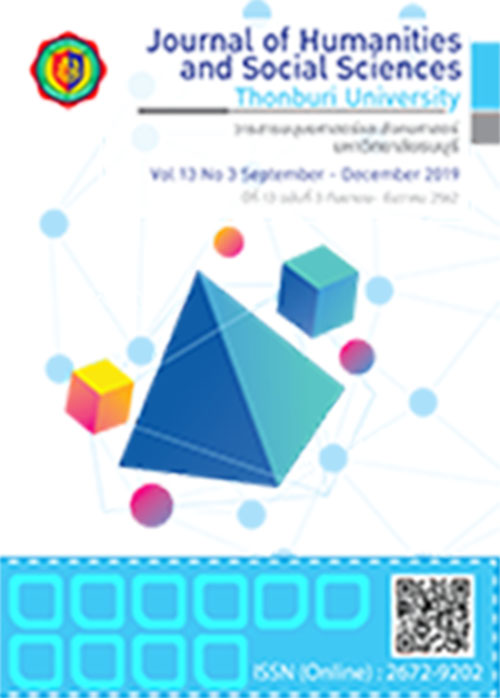RESPONSE RATE IN QUANTITATIVE RESEARCH
Keywords:
Response Rate, Questionnaire, Quantitative ResearchAbstract
This article examines and represents the response rate of the research questionnaires. As the questionnaire is the important and popular tool used for gathering data from the large number of sample and test of hypothesis according to the quantitative research method. Thus, the response rate of questionnaire is a measurement tool that provides valuable insight into accuracy of collected data that refers to the number of sample who completed the survey and it can measure whether the data analyzed is sufficient enough to meet the basic criteria to determine the sample by using response rate of questionnaires in quantitative research in various forms which consisted of 1) Self-administer questionnaire 2) Mailed questionnaire 3) Facsimile questionnaire and 4) Web Based questionnaire. From the synthesis, researchers should use a self-administer questionnaire, by phone or conference call. This will allow the data from the sample to match the study population and the reliability of the data. The data can be collected enough to test the hypothesis. It is also reliable and the error of all data is low.
References
การวิจัยเชิงปริมาณ. (2560). สืบค้นเมื่อ 19 พฤศจิกายน 2560, จาก http://nakhonsawanresearch.blogspot.com/ 2011/07/quantitative-research.html.
เกียรติคุณบุญธรรม กิจปรีดาบริสุทธิ์. (2549). การวิจัยเชิงปริมาณ. สืบค้นเมื่อ 20 พฤศจิกายน 2560, จาก http://nakhonsawanresearch.blogspot.com/2011/07/ quantitative-research.html
ประสพชัย พสุนนท์. (2560). การวิจัยเชิงปริมาณ. ในเอกสารประกอบการเรียนการสอนระเบียบวิธีวิจัยเชิงปริมาณ. คณะวิทยาการจัดการ มหาวิทยาลัยศิลปากร.
ปรีดา เบ็ญคาร. (2539). การวิเคราะห์อภิมานของปัจจัยที่มีผลต่ออัตราการตอบกลับแบบสอบถามที่ส่งทางไปรษณีย์. วารสารวิธีวิทยาการวิจัย จุฬาลงกรณ์มหาวิทยาลัย.
สุชาติ ประสิทธิ์รัฐสินธุ์; และ บุญธรรม กิจปรีดาบริสุทธิ์. (2521). ระเบียบวิธีวิจัยทางสังคมศาสตร์. กรุงเทพฯ: ศรีอนันต์.
สุภาพร โกเฮงกุล. (2523). อิทธิพลของคำถามที่มีผลสะท้อนและการลงชื่อที่มีต่ออัตราการตอบแบบสอบถามที่ส่งทางไปรษณีย์. วิทยานิพนธ์ครุศาสตร์มหาบัณฑิต, บัณฑิตวิทยาลัยจุฬาลงกรณ์มหาวิทยาลัย, กรุงเทพมหานคร.
สุวรรณ สุวรรณเวโช. (2525). หลักการวิจัยทางสังคมศาสตร์ แนวการเขียนวิทยานิพนธ์ รายงานทางการวิชาการและรายงานประจำภาค. กรุงเทพฯ: ไทยวัฒนาพานิช.
Baruch, Y. (1999). Response rates in academic studies-a comparative analysis. Human Relations. 421-434.
Berdie, D.R., Anderson J.F., & Niebuhr MA. (1986). Questionnaires: design and use. Metuchen, N.J.: Scarecrow Press
Best, J. W. & Khan, J. V. (1998). Research in Education. Needham Heights: Allyn & Bacon.
Cihan Cobanoglu, Bill Werde; & Patrick J. Moreo. (2001). A comparison of mail, fax and Web-based survey methods, University of Delaware and Oklahoma State University, International. Journal of Market Research.
Couper, M. P. (2000). Web Surveys–A review of issue and approaches. Public Opinion Quartery. 464-494.
Dillman, D. A. (2000). Mail and Internet Surveys: The Tailored Design Method. New York: John Wiley& Sons.
Efax.com. (2017). [online] https://www.efax.com
Fricker, R. D., & Schonlau, M. (2002). Advantages and Disadvantages of Internet research surveys: Evidence from the literature. Field Methods. 347-367.
Groves, R. M. (1989). Survey errors and survey costs. New York: Wiley.
Hardigan, P.C., Succar, C.T. & Fleisher, J.M. (2012). An Analysis of Response Rate and Economic Costs Between Mail and Web3 Based Surveys Among Practicing Dentists: A Randomized Trial. J Community Health. 383-394.
Hoonakker, P.L.T. & Carayon, P. (2009). Questionnaire Survey Nonresponse: A comparison of postal mail and Internet surveys. International Journal of Human Computer Interaction (IJHJI). 25(5):1, 348-373.
Kerlinger, F. N. (1986). Foundations of behavioral research. 3rded. New York: Holt. Rinehart& Winston.
Malhotra, M. K. and Grover, V. (1998). An assessment of survey research in POM: from constructs to theory. Journal of Operation Management.16(4): 407-425.
Mitchell, R.C. (1989). Resources for the Future. Using surveys to Value Public Goods: The Contingent Valuation Method.
Robert M. G. and Lars L. (2010). Total Survey Error: Past, Present, and Future: American association for public opinion research. 74(5): 849–879.
Translated Thai References
Bankan, P. (1996). A meta-analysis of factors affecting response rates to mailed questionnaires. Journal of Research Methodology. Chulalongkorn University. thesis, academic reports and regional reports. Bangkok. Thaiwattanaphanit. (in Thai)
Kijpredarborisuthi, B. (2006). Quantitative Research. (Online). Retrieved 29 April 2017, from http://nak honsawanresearch.blogspot.com/2011/07/quantitative-research.html. (in Thai)
Kohengkul, S. (1980). The effects of sensitive items and signing one’s name to a questionnaire upon the response rate of mailed questionnaires. The master of ducation thesis, Graduate School, Chulalongkorn University, Bangkok. (in Thai)
Pasunon, P. (2017). Quantitative Research. In the quantitative research methodology learning and teaching materials. (in Thai)
Quantitative Research. (2017). (Online) Retrieved 29 April 2017, from http://www.dmh.go.th/news/ view.asp?id=964 (in Thai)
Rasithrathsint, S.;& Boontham, K. (1978). Research Methodology in social science. Bangkok: Srianun. (in Thai)
Sombutteera, K.;& Thavornpitak, Y. (2015). Response Rate and Factors Associating Mailed Questionnaire Response Rate in Nursing Sciences and Public Health Research. KKU Research Journal. (GS.) 15 (1). (in Thai)
Suwanvecho, S. (1982). Principles of social science research, writing guidelines for thesis, academic reports and regional reports. Bangkok. Thaiwattanaphanit. (in Thai)







